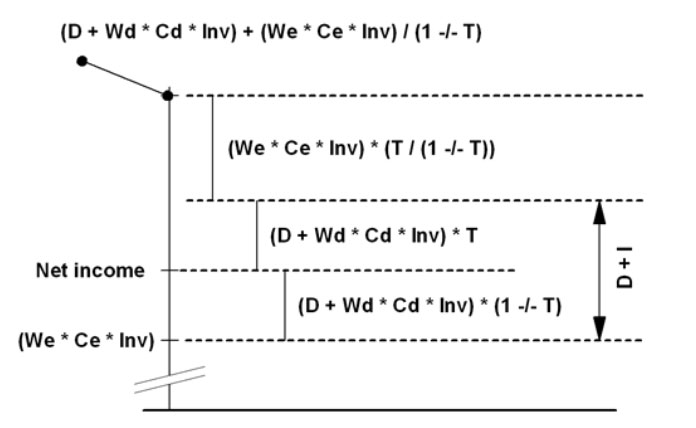Minimal Operating Surpluses i.e. The RED LINE

What operating surpluses are needed, at least? The bare minimum. Neither gaining nor losing money. This article gives the answer to this vexed question. It revolves around monitoring the operating surpluses on almost the top line of the cash flow calculation scheme. Periodical net cash flow information is rather late in being available. Steering on real time developing operating surpluses (to be compared to the best possible pattern that is indicating the red line) is far better than steering from the back seat, lead by various series of cash flows on the bottom line. The bare minimum is indicated by not losing money. Where is the red line?
To avoid latent taxes (to keep things simple) and also linear depreciations; these depreciations happen to be superfluous money in the operations department until the end of the economic life cycle. Superfluous money is transferred normally to a financial department. It’s up to the investor or the manager to decide how the company should perform at different points in the project/product life cycle.
Inv (Investment) 250,000 money units; life cycle four consecutive periods. Depreciable machines, fiscally and economically over a three-period life cycle by the ‘straight-line’ method (i.e. at 1/3 of cost per period); the residual value fiscally and economically is $ 40,000. The geared proportion, as mentioned below, is normal. There are of course production/selling facts and complementary costs resulting in operating cash flows at the end of each period.
D (Depreciation) amount [money units]. TV (True Value of asset) at any moment, fiscally and economically. I (Interest) amount [money units]. T (Tax rate) 35 %. We (Weight of equity) 50 %. Wd (Weight of debt) 50 %. Ce (Cost of equity) 15.55 %. Cd (Cost of debt) 13 % before tax. Presupposition is a SBU (Strategic Business Unit) that is responsible for the invested capital from start to finish. Reinvestment of depreciation(s) returns at least WACC, theoretically. From period 2 on, there is not just ‘net profit operational’ but also ‘net profit additional investments’ of the cumulative value differences i.e. total depreciations; the latter equals at least WACC = 12 %. Net return 12 % on the first 70,000 reinvestments of depreciation is 8,400 money units and this amount divided by (1 -/- tax rate 0.35) results in 12,923.076… money units (less necessary operating surplus) in period 2. And so on, and so forth. For more about WACC, re my freely downloadable paper ‘The One and Only Standard WACC – Cost of Capital versus Return on Capital’ http://ssrn.com/abstract=756105
If and when D = 0:
We * Ce * Inv = 0.50 * 0.1555 * 250,000 = 19,437.50
(Wd * Cd * Inv) * (1 -/- T) = (0.50 * 0.13 * 250,000) * (1 -/- 0.35) = 10,562.50 and both together i.e. minimum net income is 30,000.
To arrive at this net income, one needs an operating surplus of X.
{X -/- (Wd * Cd * Inv)} * 0.65 = 19,437.50 and it follows X = 46,154 i.e. operating surplus from period 1 up to and including period 4, ending up in We * Ce * 250,000 = 19,437.50
It is easy to include D = 70,000 into the calculations. In period 1 (see sketch below), total proceeds = total sacrifices:
Linear depreciation instead of real value differences is a limited model of the reality. This is a simple calculation, just to make a start. Next one has to face the whole reality and all simultaneously. Operating surpluses are rather high in outperforming periods of the economic life cycle (one will see some relatively high periodic operating surpluses) and operating surpluses usually diminish at the end of the economic life cycle. Sales, costs and operating surplus, they develop, as time goes by during a period. Periodical net cash flow is available rather late. Steering on real time developing operating surpluses (to be compared to the best possible pattern) is far better than steering from the back seat, regarding various series of cash flows. Indeed various Operating Cash Flows (OCFs) are possible. Which OCF is in use in a particular situation? Higher operating surpluses, above the red line, will result in higher net profits operational and higher net profits in total respectively. A strategic investment proposal must normally be underpinned thoroughly. Nevertheless, the presented schemes (see them and a lot more) in my freely downloadable paper ‘Tax Shields, WACC, NPV, EVA®, CVA®, NVA and Profitability Analyses’ http://ssrn.com/abstract=552188) with subtitle ‘Minimal Operating Surpluses i.e. The RED LINE‘ are basically correct and the same schemes can be repeated – as calculations are exercised regarding a real investment – including literally everything.
{Y -/- (D + Wd * Cd * Inv)} * 0.65 = 19,437.50
{Y -/- (70,000 + 0.50 * 0.13 * 250,000)} * 0.65 = 19,437.50
It follows Y = 116,154 i.e. operating surplus in period 1. In period 2 it is 103,231, in period 3 it is 90,308 and finally in period 4 it is 7,385 rounded in whole money units.
NPV at 12 % of total operating surpluses is 254,976.801… in order to arrive at a zero result finally i.e. neither gaining EXTRA nor losing money.
Equal operating surplus (an equivalent pattern)
Annuity = {(0.12 * 254,976.801… * (1.12)^4}/{(1.12)^4 -/- 1} = 83,947.143…
Equal operating surpluses of $ 83,947 each period.
Operating surplus, diminishing each period by 10 %
It holds:
Equivalent is also a pattern diminishing each period by 10 %.
Conclusion
The operating surpluses in subsequent periods, totally, are what matters; they can be spread over the periods in many different ways. Of course one has to do the utmost in order to arrive at the best possible pattern. NPV at 12 % of total operating surpluses amounts to 254,976.801…; this indicates the red line. Higher operating surpluses, above the red line, will result in higher net profits and also a positive NVA (Net Value Added) altogether at t = 0. Before tax means tax rate is zero. The calculation itself, the scheme, is exactly the same in all respects; substitute T = 0, that is all.
Have you read?
# Best CEOs In the World Of 2022.
# TOP Citizenship by Investment and Residency by Investment Programs, 2022.
# Global Passport Ranking, 2022.
# The World’s Richest People (Top 100 Billionaires, 2022).
# Best Novels to Read of 2021.
# Economy Rankings: Largest countries by GDP, 2022.
Bring the best of the CEOWORLD magazine's global journalism to audiences in the United States and around the world. - Add CEOWORLD magazine to your Google News feed.
Follow CEOWORLD magazine headlines on: Google News, LinkedIn, Twitter, and Facebook.
Copyright 2025 The CEOWORLD magazine. All rights reserved. This material (and any extract from it) must not be copied, redistributed or placed on any website, without CEOWORLD magazine' prior written consent. For media queries, please contact: info@ceoworld.biz











